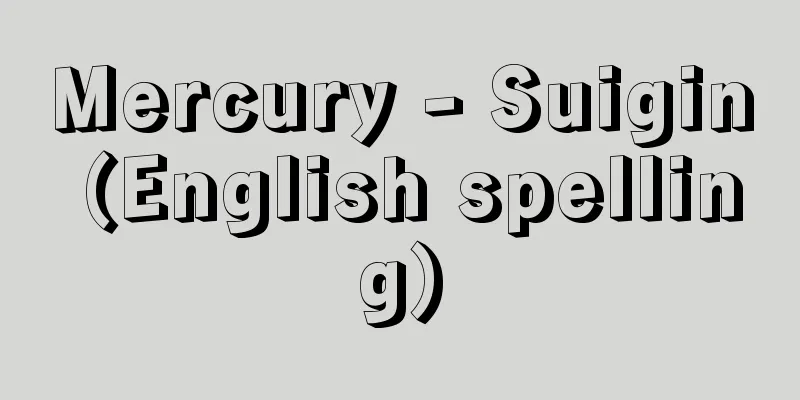Mercury - Suigin (English spelling)

|
It belongs to group 12 of the periodic table and is one of the zinc group elements. It is the only metal that is liquid at room temperature. historyIt is one of the important metals known since ancient times, and its compounds have been widely used in China, India and other countries since ancient times for preservation and other purposes, and it has been found in Egyptian tombs from around 1500 BC. The first reliable and detailed report on the extraction of mercury by burning cinnabar (HgS) was made by Theophrastus of Rome around 300 BC, and there are records that mercury was already used to extract gold from gold ore around the end of the 6th century. However, there are evidences of gold plating using mercury amalgam much earlier than that, for example, on excavated items from ancient tombs in Egypt, China, Korea and other countries, so it is believed that the use of mercury began in a very ancient period. The word "dan" was already mentioned in the Huainanzi, a book from the Western Han Dynasty, and the 3rd century book "Huobuzheng" contains a passage that says, "Cinnabar is burned to produce mercury." In Japan, there are many records about mercury in the Fudoki and Nihon Shoki, and there are ancient Nyu Shrines in various places that are related to mercury extraction. For example, the Great Buddha of Todaiji Temple was plated using the amalgam method, and it is recorded that 10,436 ryo of metal and 58,602 ryo of mercury were used (Todaiji Yoroku). In other words, the amalgam mixture ratio at that time was 1:5.6. The fact that mercury is a liquid and that it can dissolve many metals to form amalgams was of particular interest to alchemists, who believed that mercury was the common component of all metals and that by varying the amount of mercury, one metal could be transformed into another. [Nakahara Katsunori] Origin of the nameMercury is called hydrargyrum in Latin, which is derived from the Greek words hydr, meaning water, and argyros, meaning silver, from which the atomic symbol Hg is taken. There is also another Latin name, mercurium, but in medieval Europe, the seven elements of gold, silver, mercury, copper, iron, tin, and lead were associated with the stars of the solar system, the Sun, Moon, Mercury, Venus, Mars, Jupiter, and Saturn, and mercury was named as a reference to the planet Mercury, from which the English and French names come. Mercury has been called Suigin in China since ancient times, and in Japan it is called Mizugane (water mercury). Mercury (kou) is a synonym for mercury. [Nakahara Katsunori] ExistenceIt is rarely found in a free state (it is thought that much of the free metal was extracted in ancient times). The main ore is cinnabar. The world's main sources of cinnabar are Spain and America, and Almaden in Spain has been known as a cinnabar source since Roman times. In Japan, it was produced quite widely in the past, but now it is only produced in very small areas (for example, Hokkaido and Nara Prefecture), and the country is almost entirely dependent on imports. [Nakahara Katsunori] Manufacturing methodMercury and its minerals have a high specific gravity, so they are concentrated by gravity separation, and fine powders such as cinnabar are separated by flotation. The ore is then heated in air, and the liberated mercury vapor is led to a cooling chamber where it is condensed. HgS + O2 -> Hg + SO2 To purify mercury for laboratory use, it is covered with an aqueous solution of iron(III) sulfate acidified with sulfuric acid, and air is blown in to oxidize the impurities, which float to the surface and can be separated. It is then washed by repeatedly dropping it into a dilute nitric acid or nitric acid-acidified mercury nitrate solution, and then distilled under reduced pressure. [Nakahara Katsunori] natureIt is a heavy liquid with a silvery-white metallic luster. In solid form, it has a tin-white metallic luster, and is malleable and ductile, making it possible to cut it with a knife. Its specific gravity is 13.5462, and its vapor pressure is 1.20×10 -3 mmHg (both at 20°C). It has a high coefficient of expansion, and is constant over a fairly wide temperature range. It forms amalgams with many metals except for iron, nickel, cobalt, and magnesium, so it is usually stored in iron containers. It does not dissolve in hydrochloric acid, but dissolves in nitric acid to become mercury nitrate. In air, it is stable if dry, but becomes mercury oxide at temperatures above 300°C, and decomposes to mercury again at temperatures above 400°C. In moist air, the surface oxidizes to form a gray film. It also easily forms mercury sulfide when rubbed with sulfur. [Nakahara Katsunori] ApplicationsIn its metallic state, it has a wide range of uses, including thermometers, barometers, many scientific instruments, mercury lamps, rectifiers, vacuum pumps, etc. Industrially, it has been used to produce caustic soda by electrolysis of salt water (though this use is no longer used due to the risk of environmental pollution caused by mercury), and is also used in the manufacture of various pharmaceuticals. It is also used in pesticides, explosives, and dental amalgam. [Nakahara Katsunori] NoteWhen liquid mercury is left in the air, it gradually disperses as vapor. Inhaling even small amounts of this vapor over a long period of time can cause symptoms of poisoning. Many mercury compounds are also toxic; for example, mercury chloride (mercury(II) chloride) has a lethal dose of 0.6 grams. Poisoning from organic mercury is known as a pollution problem, including Minamata disease. [Nakahara Katsunori] "Mercury" by Kitamura Masatsugu, Kondo Masaomi, and others (1976, Kodansha) " ▽ "Cultural History of Metals" edited by Tanigawa Kenichi (1991, San-ichi Shobo)" ▽ "Inorganic Mercury" by WHO, translated by the National Minamata Disease Research Center (1992, Japan Public Health Association)" ▽ "The Science of Minamata Disease by Nishimura Hajime and Okamoto Tatsuaki (2001, Nippon Hyoronsha)" [References] | | | | | | | | | | | | | | | | | | | | [Supplementary information] |©Shogakukan "> Periodic Table ©Shogakukan "> Example of a mercury-containing waste recycling plant ©Shogakukan "> Specific gravity and vapor pressure of mercury Cinnabar is placed in a closed kettle, and an iron distillation tube wrapped in hemp rope is attached to the top. Mercury vapor is introduced into the water and condensed to obtain mercury. "Tenko Kaibutsu" Volume 2 "Tansei" 16th National Diet Library Collection "> The smelting of mercury as seen in "Tenkou Kaibutsu" Source: Shogakukan Encyclopedia Nipponica About Encyclopedia Nipponica Information | Legend |
|
周期表第12族に属し、亜鉛族元素の一つ。常温で液体である唯一の金属。 歴史古代から知られていた重要な金属の一つで、中国、インドなどで古くから保存用その他として化合物が広く用いられており、紀元前1500年ごろのエジプトの墓中からも発見されている。辰砂(しんしゃ)HgSを焼いて水銀を取り出すことについては、前300年ごろローマのテオフラストスによって初めて確実で詳細な報告がなされており、6世紀の末ごろには金鉱石から金を抽出するのにすでに水銀が用いられたという記録がある。しかし、それよりはるかに古く、たとえばエジプトや中国、朝鮮その他の古墳の発掘品に、水銀アマルガムを用いて金めっきを行った形跡のあることがわかっており、水銀の使用が始められたのはきわめて古い時代のことであったと思われる。前漢のころの書『淮南子(えなんじ)』にはすでに「丹(たん)」の記載があり、3世紀の『博物証』には「丹砂を焼けば水銀を成す」という文章が残されている。日本でも『風土記(ふどき)』や『日本書紀』には水銀についての多くの記載が残されており、水銀採取に関係のある神社として古くからの丹生(にう)神社は各地に存在している。また、たとえば東大寺の大仏建立にはアマルガム法によるめっきが行われ、使用された錬金(ねりがね)1万0436両、水銀5万8602両という記載が残されている(『東大寺要録』)。すなわち、このときのアマルガム配合比は1対5.6である。 水銀が液体であることと、多くの金属を溶かしアマルガムをつくることは、とくに錬金術師たちに注目されていた。すなわち、水銀はすべての金属の共通成分であり、水銀の含有量を変えることで、ある金属を他の金属に変えることもできるというように考えられていた。 [中原勝儼] 命名の由来水銀はラテン語でhydrargyrumというが、これは、ギリシア語で水を意味するhydrと銀を意味するargyrosからつくられたもので、原子記号のHgもこれからとったものである。また、ラテン語にはもう一つのmercuriumという名称があるが、これは中世ヨーロッパでは、金・銀・水銀・銅・鉄・スズ・鉛の7種を、太陽系の星、太陽・月・水星・金星・火星・木星・土星に対応させていたので、水銀は水星を意味するmercuryに関係するものとして命名されたもので、英語およびフランス語はこれからきている。中国ではきわめて古くから水銀と称しており、日本では水銀(みずがね)とよんでいた。汞(こう)は水銀と同義語である。 [中原勝儼] 存在遊離状態ではまれにしか産しない(遊離金属は古代に多く取り出されてしまったものと考えられている)。主要鉱石は辰砂である。世界的な産地はスペインおよびアメリカで、とくにスペインのアルマデンは辰砂の産地としてローマ時代から知られている。日本では古くはかなり広く産していたが、現在ではきわめてわずか(たとえば北海道、奈良県など)に産するのみで、ほとんど輸入に頼っている。 [中原勝儼] 製法水銀およびその鉱物は、比重が大きいので重力選鉱などで濃縮し、辰砂などの微粉を浮選によって分離する。ついで鉱石を空気中で熱し、遊離した水銀蒸気を冷却室に導いて凝縮させてつくる。 HgS+O2―→Hg+SO2 実験室で用いられる水銀を精製するには、硫酸酸性の硫酸鉄(Ⅲ)水溶液で水銀を覆い、空気を吹き込み、不純物を酸化すると表面に浮くので、これを分離する。ついで、希硝酸または硝酸酸性硝酸水銀溶液中で繰り返し滴下して洗い、減圧蒸留する。 [中原勝儼] 性質銀白色の金属光沢をもつ重い液体。固体ではスズ白色の金属光沢となり、展性、延性も大きく、ナイフで切断できるようになる。比重は13.5462、蒸気圧は1.20×10-3mmHg(いずれも測定温度20℃の場合)である。膨張率は大きく、しかもかなり広い温度範囲で一定である。鉄、ニッケル、コバルト、マグネシウムなどを除いた多くの金属とアマルガムをつくるので、貯蔵には普通、鉄の容器が用いられる。塩酸には溶けないが、硝酸に溶けて硝酸水銀となる。空気中では、乾燥していれば安定であるが、300℃以上では酸化水銀となり、400℃を超えると分解してふたたび水銀となる。湿った空気中では表面が酸化されて灰色の被膜を生ずる。また硫黄(いおう)とこすると、たやすく硫化水銀を生ずる。 [中原勝儼] 用途金属の状態で、温度計、気圧計や多くの理化学器械、水銀灯、整流器、真空ポンプなどその用途は広い。工業的には食塩水の電解によるカ性ソーダ製造に用いられたことがあり(水銀による環境汚染の原因となるとして使用されなくなった)、各種薬品製造にも用いられる。そのほか農薬、火薬、歯科用アマルガムとして用いられる。 [中原勝儼] 注意液体の水銀は、空気中に放置すると蒸気としてわずかずつ拡散する。これをわずかずつでも長期間吸入すると中毒症状を呈する。水銀の化合物にも有毒なものが多く、たとえば昇汞(しょうこう)〔塩化水銀(Ⅱ)〕は致死量0.6グラムとされており、また有機水銀による中毒は、水俣病(みなまたびょう)をはじめ公害問題として知られている。 [中原勝儼] 『喜田村正次・近藤雅臣他著『水銀』(1976・講談社)』▽『谷川健一編『金属の文化誌』(1991・三一書房)』▽『WHO著、国立水俣病研究センター訳『無機水銀』(1992・日本公衆衛生協会)』▽『西村肇・岡本達明著『水俣病の科学』(2001・日本評論社)』 [参照項目] | | | | | | | | | | | | | | | | | | | | [補完資料] |©Shogakukan"> 周期表 ©Shogakukan"> 水銀含有廃棄物再資源化プラント例 ©Shogakukan"> 水銀の比重と蒸気圧 上方をふさいだ釜の中に辰砂(丹砂)を入れ、その上部に麻縄を巻いた鉄の蒸留管を取り付け、水銀蒸気を水の中に導いて凝縮させ、水銀を得る。『天工開物』 下巻 「丹青」 第16国立国会図書館所蔵"> 『天工開物』にみる水銀の製錬 出典 小学館 日本大百科全書(ニッポニカ)日本大百科全書(ニッポニカ)について 情報 | 凡例 |
Recommend
cable railway
...Some were built underground (Glasgow). In Engl...
Troost, C. (English spelling) TroostC
...This stagnation continued long into the 19th c...
Retsuko - Retsuko
Date of birth and death unknown. An ancient Chine...
Premolar - Premolar
…Humans have eight deciduous teeth, two on each s...
gold key
…During the 18th and 19th centuries, many Europea...
Guthrie, W.
…American folk singer, guitarist, banjoist, and c...
Principal and interest calculation - Ganri Keisan
The ratio of the sum of dividends and capital gai...
Clan God - Shizokushin
The guardian deity of a clan. In most cases, a com...
Proculus, S. (English spelling) ProculusS
…He was of southern Italian descent and served as...
Rhyming book - Insho
A dictionary that classifies and arranges Chinese...
Noh costume - Noh costume
A general term for costumes used in Noh. In the n...
Sample survey - Hyohonchosa (English spelling)
It is also called a sampling survey. There are tw...
Arthropods - Animals
In animal taxonomy, this group of animals is clas...
Donatus
…A Christian schismatic sect that arose in North ...
Lewin tube
…A thin tube inserted into the stomach through th...









